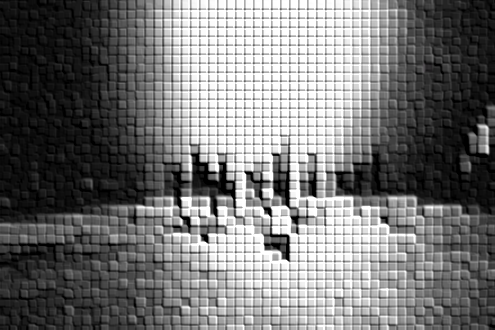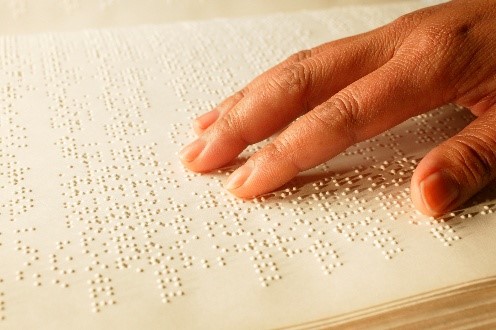This topic came to me as I was talking, over the phone, with my blind sister. She lives in Canvey Island, Essex, United Kingdom and I live in Kampala Uganda. She lives alone in her house taking care of herself: shopping, cooking, house maintenance etc. Every time I visit her; I am amazed by how she adapted to her condition and moved on in life.
 A brief background about my sister. My sister was not born blind but became blind overnight about 55 years ago. She was in her final stages at university, sitting her final examinations for a B.Sc. degree in Agriculture. She was staying with me in Kampala and, one night, as she was going to the bathroom, she fell and called me. She had lost her sight just like that. As a family we scrambled to find out why she had suddenly become blind and figure out how to support her in her new situation. For example, we enrolled her in a school for the blind to learn braille. She accepted her condition and adjusted her life. Over time she recovered tunnel vision in one eye which has since disappeared. Tunnel vision refers to the loss of side vision. With tunnel vision, a person can only see what is directly in front of them. As such, their vision may appear as if they were peering down a narrow tube.
A brief background about my sister. My sister was not born blind but became blind overnight about 55 years ago. She was in her final stages at university, sitting her final examinations for a B.Sc. degree in Agriculture. She was staying with me in Kampala and, one night, as she was going to the bathroom, she fell and called me. She had lost her sight just like that. As a family we scrambled to find out why she had suddenly become blind and figure out how to support her in her new situation. For example, we enrolled her in a school for the blind to learn braille. She accepted her condition and adjusted her life. Over time she recovered tunnel vision in one eye which has since disappeared. Tunnel vision refers to the loss of side vision. With tunnel vision, a person can only see what is directly in front of them. As such, their vision may appear as if they were peering down a narrow tube.
She worked for a national organization for 2 years as Personal Assistant and after 10 years as the Manager of the construction unit of that organization. She eventually moved to Britain in 1988 and became a naturalized citizen. She joined the civil service and worked for the Department of Health and Social Security, DHSS, (1988 – 1989) as an administrative officer. From 1990 she worked for the Department of Employment as an Executive Officer until her retirement on 30th of March 2018.
These details are central to the musing over my sister as an example of how to live a full life despite major physical challenges. This is a woman who as a young girl was a great tennis player, playing in the Uganda national team. She also played netball and squash until she lost sight, which was a major fork in her life’s path. She rebranded herself into a successful civil servant in a new country. Now in her mid-70s she cheerfully manages her life in retirement.
How often do able bodied people with good sight and hearing stop to reflect on the life of the people who are not like them? I sometimes see someone with severe physical handicap being wheeled and I say to myself: “It is by the Grace of God, but there I am in that wheelchair”. While over the years I have regularly kept in touch with my sister by telephone, I had never mentally placed myself in her situation to “appreciate” how I would have handled life in her position. It happened when we were talking about mobility demands that arise with aging.
She said she was beginning to have problems with one of her legs and was concerned that it could be onset of arthritis or some disease that would make movement difficult. She went on to wonder jokingly, should time come when she would need to use a walking stick, how she would handle it since she must use the white cane. A white cane is a device used by many people who are blind or visually impaired allowing its user to scan their surroundings for obstacles or orientation marks but is also helpful for onlookers in identifying the user as blind or visually impaired and taking appropriate care. I sometimes use a walking stick and appreciate the dilemma a mobility challenged blind person would be in if he/she need that support for mobility and a white cane for guidance.

Blind or visually impaired individuals face unique challenges in their daily lives that can vary depending on the level of vision loss, environment, and availability of resources. Common challenges include, for example: (1) navigation and mobility especially in unfamiliar environments or presence of obstacles in their way. (2) Lack of routine printed information material in braille such as menus, advertising brochures etc. (3) Negative stereotyping about their abilities by employers or educators and society in general creating barriers to access workplaces and educational institutions, and many more. I cannot pretend to know all the challenges visually impaired individuals face.
Routine activities such as organizing clothes in one’s wardrobe, handling currency, identifying products, shopping and cooking, can obviously be very challenging without adaptations. I believe the challenges differ among individuals depending on the environment they live in and the support they have.
Where sighted people may decide to keep information about their health private, visually impaired people may find it difficult to do so. They depend on others to interpret medical information and have challenges accessing medical forms, prescriptions, and visual-based diagnostic tools. Their privacy is then compromised by circumstances.
My sister is a bubbly woman with a sense of humour. She went on to mention her daily challenges of things a sighted person does not even think about. She talked of some of her challenges such as bumping into lamp posts and apologizing thinking that the obstacle is a person or walking in a shop or supermarket without knocking down displays, some of which could be delicate and easily breakable.

Try going to a restaurant blindfolded and see (pardon the pun) how you would handle the experience. My sister said that when she goes to a restaurant, she asks someone to read the menu to her and orders food she can easily eat with her fingers rather than with a knife and fork.
Imagine walking in the house with grocery shopping and the bag containing, say, tomatoes raptures and the contents spill out. To you and me, the sighted, it is no big deal. We would put the rest of the shopping down and pick up the spilled items. It is not that simple for my sister. She said that first she would not know how many items have fallen out of the shopping bag or where they have scattered as she goes down on her knees to start searching for them by moving her hands left and right as she crawls over the room. If any is not located the chances are that it will be squashed when she eventually steps on it, or it will remain undiscovered and rot wherever it would have rolled to until her house cleaners come over for their weekly task.
As I reflect on what it takes for the blind or visually impaired person to succeed in a world designed for the sighted, I believe that personal attributes, societal support, and technological developments for the impaired come into play.
Personal attributes include: (1) resilience and determination, the ability and motivation to take daily life obstacles as challenges to be overcome. (2) Being adaptable to different methods of executing tasks and ready to embrace new technologies designed to support people in that situation such as use of the white cane or voice operated equipment. (3) Assertiveness and readiness to articulate one’s rights. To be able to articulate their rights, individuals with disabilities need to be assertive and know the legal frameworks and support systems such as the United Nations Convention on the Rights of Persons with Disabilities (NCRPD). This is an international human rights convention that sets out the fundamental rights of people with disabilities and aims to protect and promote their rights worldwide. Assertiveness is an essential skill in navigating social, professional, and personal environments for people with disabilities. They face barriers to asserting themselves due to misconceptions, societal biases, or a lack of accessible modes of communication. (4) Readiness to master life skills necessary for independent and decent living. For example, the celebrated blind musician, Ray Charles Robinson, blinded at the age of seven years, enjoyed playing chess. He used a special board with raised squares and holes for the pieces. (5) Willingness to seize opportunities for education and professional training accessible for people with sight impairment.
Societal support includes encouragement and practical help from family and friends, and community networks promoting inclusion of people with physical or mental challenges and provide emotional support. It also includes public education to remove stereotyping and misconceptions about blindness; for people to understand that blindness does not equate to incompetence.
My sister has also shown me that it is important to maintain a positive outlook despite societal environmental barriers encountered by visually impaired people; and that it is possible to celebrate achievements and live a life full of self-confidence.
Sophisticated technological developments for the visually impaired such as braille displays, specialized communication devices etc. are expensive when available and are likely to have limited maintenance facilities in many countries. My sister is lucky that she lives in an environment where these support systems are available albeit not cheaply.
Voice-activated applications have become integral parts of modern life in some parts of the world, offering a range of functionalities that enhance convenience and accessibility. For visually impaired individuals, these technologies can be a life changer, providing relative independence to the user and ability to handle daily tasks. I have come to admire these technologies as I have watched my sister use them in her home and become a communication bridge with the people she wants to connect with.
We are a very close-knit family, and my sister felt isolated for so many years until she mastered the voice-driven communication system. She is now a chatty member of the family social media forum. She is lucky that she has access to that type of support for the visually challenged. Most people in her situation are languishing in social and mental isolation. I hope that as advancements in technology continue, the potential for voice-activated assistants to support and enrich the lives of visually impaired individuals will become widely available, making the world a more inclusive place for everyone.
Visually challenged individuals can effectively overcome barriers and contribute fully and meaningfully to their communities through personal empowerment, societal awareness, and institutional support.
Addressing these challenges should be apolitical and non-sectarian but focus on creating inclusive environments, improving accessibility standards, and promoting awareness about the needs and capabilities of visually impaired individuals.
My sister has taught me, at this late stage in my life, that success for blind or visually impaired individuals in a sighted world is a combination of their determination, ability to adapt, and the inclusivity of the society around them. With the right support, resources, and mindset, they can excel in any field and lead fulfilling lives. In 2004 BBC Essex awarded my sister a life achievement recognition as the person in Essex who had done best in their life that year.
Thank you for being part of the Fork in the Road Blogs: Reflections on Life. Be sure to look out for the next episode when I will be writing about Warped priorities. If you gathered something useful, please feel free to share the podcast. My books, Fork in the Road: Creating a future of value starting from where you are and A view round the bend. Setting goals for your life’s journey are available for purchase at Aristoc bookshops in Kampala, Uganda and online at Amazon.
Your comments on my musings are most welcome and let me know whether there is a topic you would like me to muse over.


Comments (5)
Shem Nnaggenda
U can never really know someone and what they experience or struggle with. I am happy for ypur sister, having seen the best of the world, playing squash and having the mental wherewithal to manage thus far. I have been myopic for 44 years now, that’s as far a disability that Limited my sports progression in soccer or so I thought. This is a story of perservance per excellence.
Rtn Stephen
Thanks Shem. You are correct. Of the thousands of people we interact with, only a handful we know what their lives are. My sister has become a living example in my life of perseverance. One reason I shared her story.
Muniini K. Mulera
Thank you for sharing your sister’s experience with us Stephen. This is another moving, humbling, and challenging lesson for me, and I am sure for very many people.
Meeting the needs of people with visual, hearing, mobility and other challenges in Uganda is an urgent opportunity for improvement. We need political leaders who can champion this and ensure appropriate legislation, implementation and enforcement of changes that make life easier for all people with such challenges. “All people” means all of us. As long as we live, our lives can change in a second. Blessings my brother.
Rtn Stephen
Thanks Muniini for visiting my website. I couldn’t agree more. We need leaders who are genuinely interested in the lives of the people they lead not thinking about themselves alone.
Samm B Musoke
I am a dedicated reader of your blogs, albeit I have been reading “kamooli” (a slit in the wall)! Although I have read this particular blog a number of times before, I revisited it this morning for resasons that will become apparent from the rest of my comments. Yesterday, my wife and I went to Canvey Island to visit Victoria. We had a blast! I had last visited with Victoria some 50-plus years ago on the Sixth Floor of Mulago Hospital after that episode when she went blind while staying with you. I had kept track of her journey through family and friends, and this blog had plugged many holes. But there was nothing like the joy of seeing Victoria in person. Re-assuringly, she still has the vivacious ability to read and lead (take gentle command of) situations and people. This is some of what endeared so many of us to her in the College of Agriculture at Makerere and in the various sports and other activities that she participated in. Victoria’s friend Frances told me that Victoria regularly visits people in their community to offer them encouragement. ……. There was laughter a plenty, including the shared memory that Victoria had no confidence in my ability to play tennis. One time at Makerere, Victoria had admonished me: “Tosobola kuzanya tennis nga racket ogikwaata nga ekiwujjo!” (“You will never be any good at tennis if you hold the racket like it is a fly swatter!”)